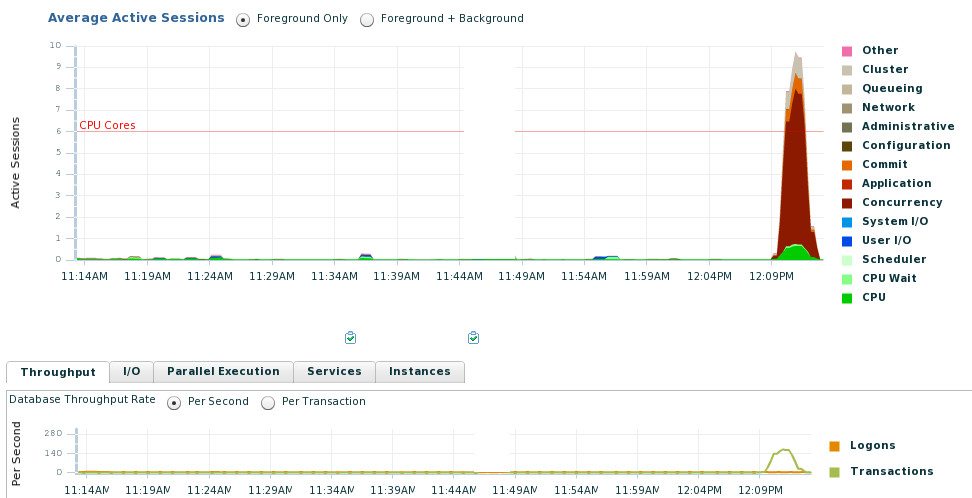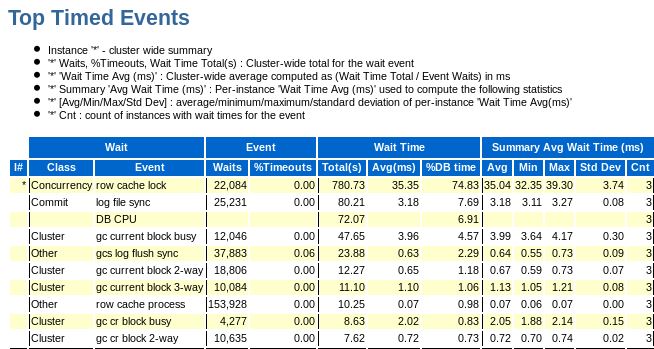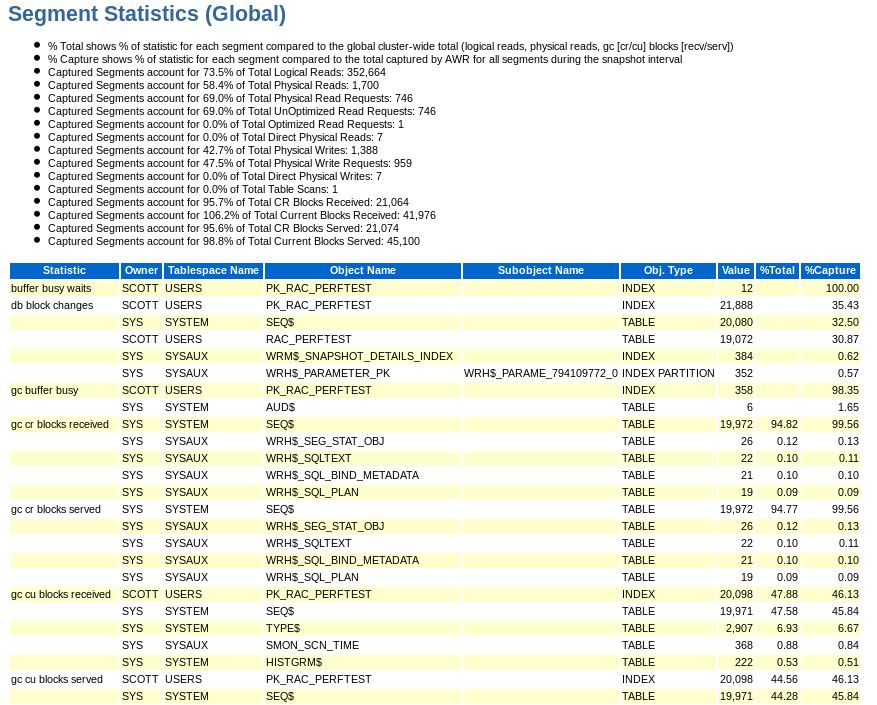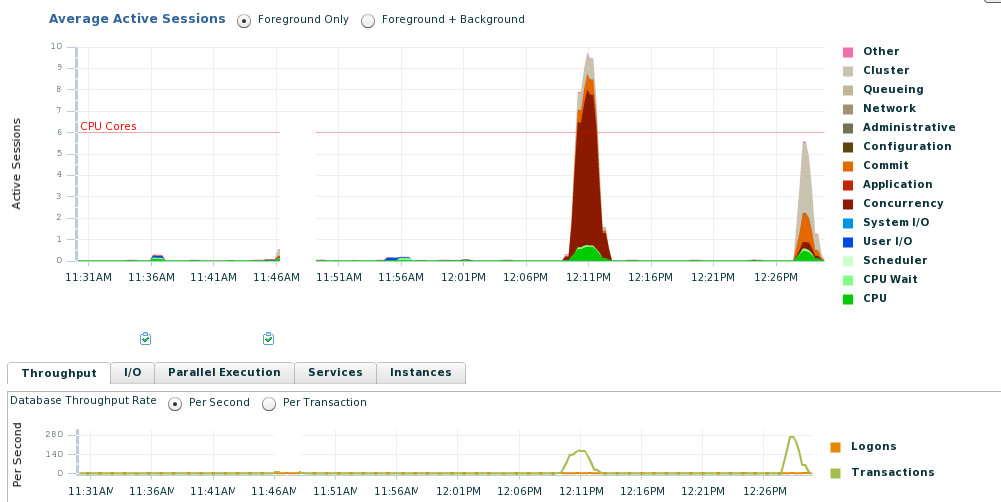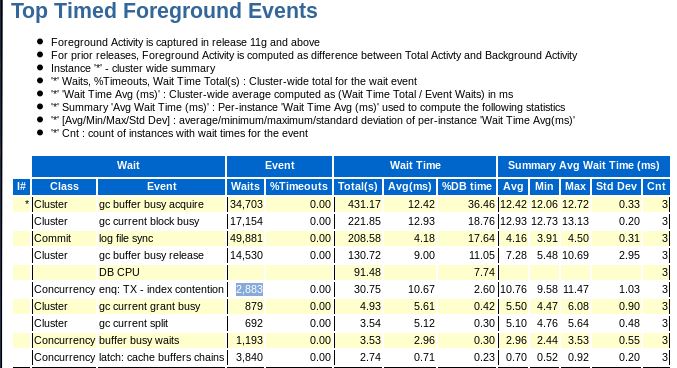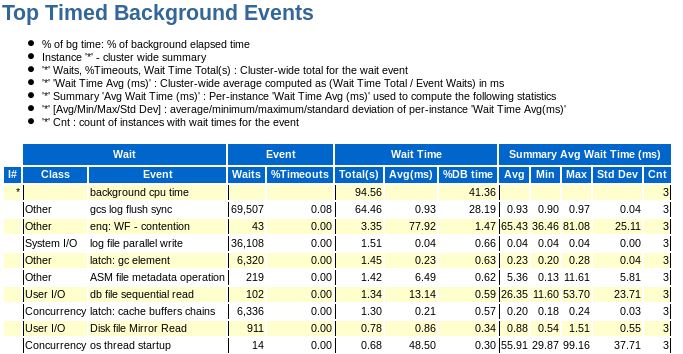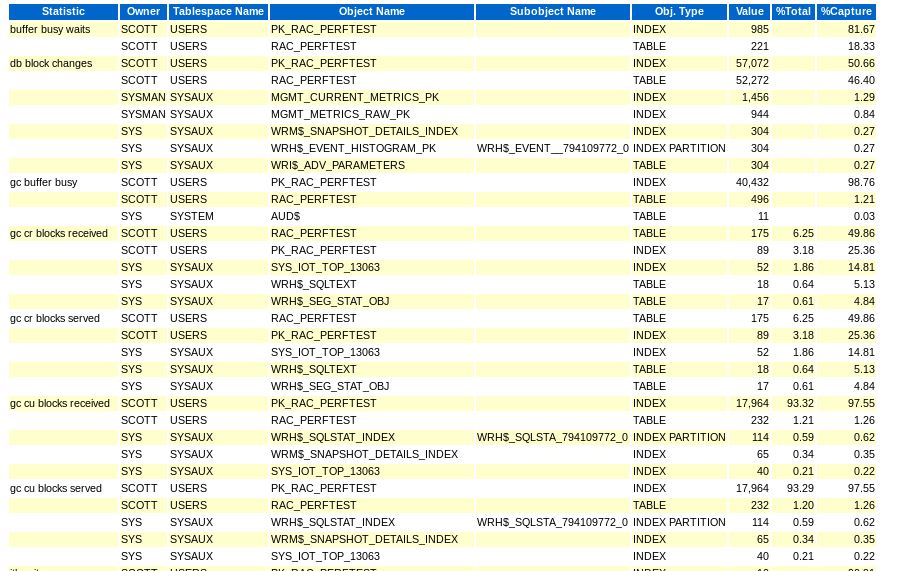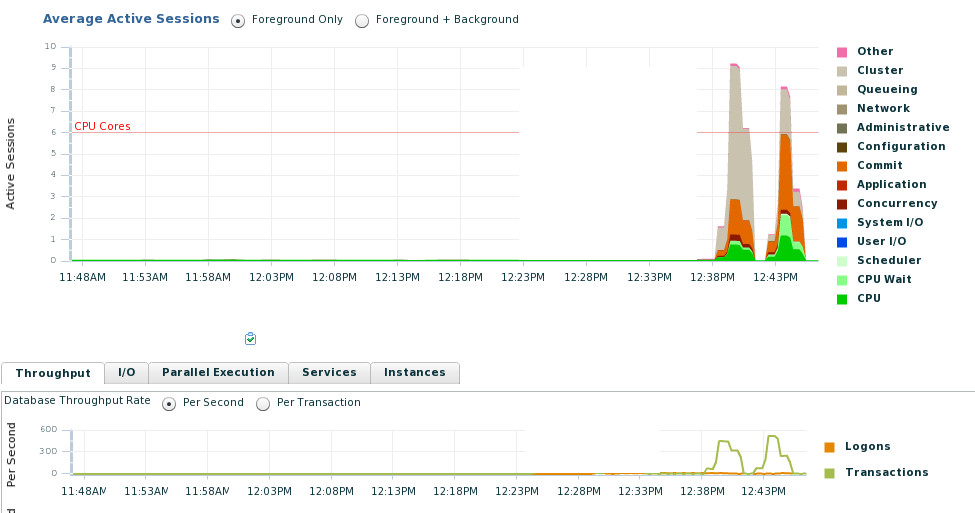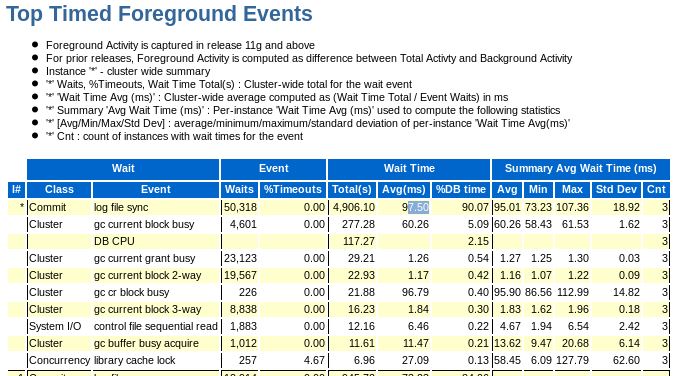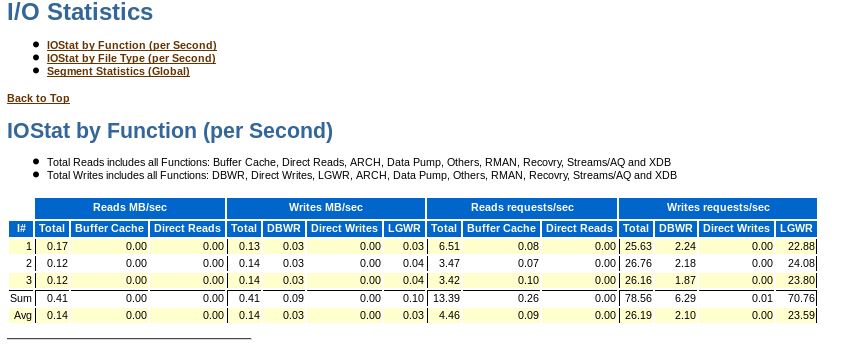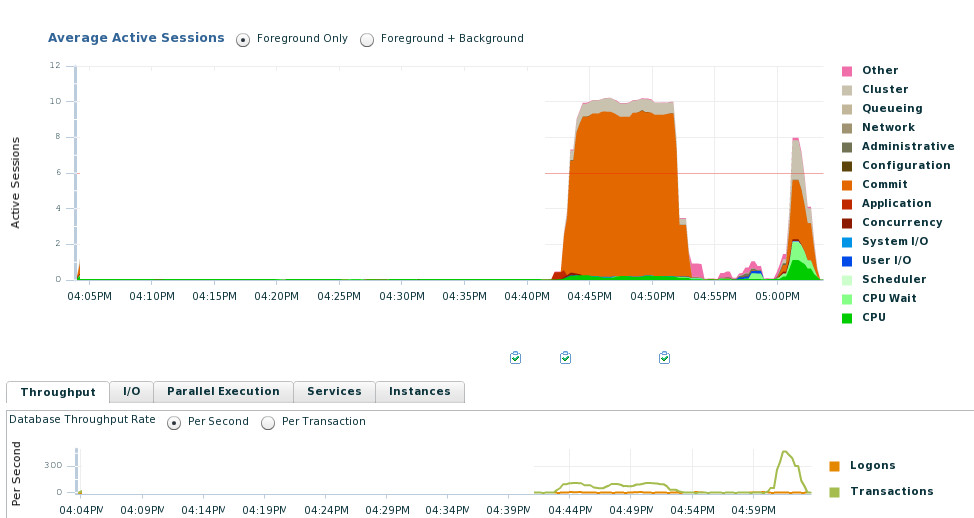Table of Contents
Overview
Elapsed time Time: Interval of time between the start and end snapshots DB Time : DB Time is the time spent in the database by Foreground Sessions which includes CPU time, IO time and No-Idle Wait time Includes Cluster Waits, Commit Waits ..... Max DB Time in Cluster: MAX DB Time = Number_of_instances * AWR_Report_time * Number_of_CPUs If it is more and multiples of elapsed time then one has to jump to the TOP 5 Timed Events sessions to investigate further. CPU Time : CPU time represents time spent on CPU and does not include time waiting for CPU
Concurrency Top Wait Event Class
EM Report
- Concurrency is the top Wait class
- Transaction rate is about 140 Tx/sec
AWR snapshot:
- There are 2 CPUs per instance / 6 cores are active for the complete cluster
- There is a huge DB Time compared to the Elapsed Time
- Question: Are we CPU bound ?
- Only about 12% from out DB Time is CPU time –> Lot of waits here
- For BG processes we don’t see to much Waits about 70% of bg time are on CPU ( bg CPU )
- The definitely means that we aren’t CPU bound so lets have a look on FG Wait TOP 5 Wait Events first
- Top Wait Event is Row cache lock with a Wait Time of 780 seconds
- Let’s see wether we can identify a SQL statement
- Checking Insert statement taking 89 % DB time insert into rac_perftest values (t1_seq.nextval, :1 , :2 , sysdate)
- Insert statement triggers a Row Cache log by using seq.nextval()
- Following statement updating/selecting seq$ are the recursive statements triggered by the insert statement
- Statement 1: update seq$ set increment$=:2, minvalue=:3, maxvalue=:4, cycle#=:5, order$=:6, cache=:7,highwater=:8, audit$=:9, flags=:10 where obj#=:1
- Statement 2: select increment$, minvalue, maxvalue, cycle#, order$, cache, highwater, audit$, flags from seq$ where obj#=:1
- Both statments update seq$ and insert into rac_perftest were executed 20.000 times. Looks like a 1:1 relationship
- Table SEQ$, table RAC_PERFTEST and Index PK_RAC_PERFTEST are changed more than 20,000 times ( db block changes Wait Event )
- Access to SEQ$ is responsible for about 20.000 Cluster Waits for gc cr blocks received/gc cu blocks received
Tuning Step 1 : Avoid sequences by using a JAVA generated sequence
Change SQL statement with sequence usage insert into rac_perftest values (t1_seq.nextval, ?, ?, sysdate) "; to a SQL statment generating a JAVA based sequence using AtomicLong datatype private static AtomicLong counter = new AtomicLong(); insert into rac_perftest values (?, ?, ?, sysdate) ";
- For more Details please read following article
Cluster Waits Top Wait Class
EM performance report
- After first tuning step ( 12:26) the Concurrency wait event was nearly completely eliminated
- Transaction rate nearly doubles
- Cluster Wait Event becomes the dominant Wait Event
AWR snapshot
- Cluster Wait Events : Gc buffer busy acquire and GC current block busy taking 54 % of our DB time
- TX index contention Wait event shows we have index block splits
- GCS log fush sync is the top Wait Event for our BG process
- This is a sample where we have some contention from the Block Sending Side as dirty buffers needs to be flushed before transfering
- GC Buffer Busy wait event listed 40.000 times together with GC current blocks received ( 18.000 times ) for Index PK_RAC_PERFTEST
- Huge Index Contention
- Insert statement insert into rac_perftest is respnsible for 99 % for our Clusterwaits
- Use 10046 trace to get an idea whether the index keys used for insert triggers a RHS index contention
Verify RHS contention using gv$active_session_history view
SQL> select /*+ materialize */ event, current_obj#, current_file#, current_block#, Count(*) CNT,
2 min(to_char(sample_time,'DD-MON HH:MI')) First_Wait, max(to_char(sample_time,'DD-MON HH:MI')) Last_Wait
3 from gv$active_session_history where event like lower('&event') and sample_time>&sample_time_start and sample_time<&sample_time_end
4 group by event, current_obj#, current_file#, current_block#
5 having count(*) >= &grp_count
6 order by CNT desc, current_block# ;
old 3: from gv$active_session_history where event like lower('&event') and sample_time>&sample_time_start and sample_time<&sample_time_end
new 3: from gv$active_session_history where event like lower('gc%') and sample_time>trunc(sysdate) and sample_time<sysdate
old 5: having count(*) >= &grp_count
new 5: having count(*) >= 5
EVENT CURRENT_OBJ# file block CNT FIRST_WAIT LAST_WAIT
-------------------------------- ------------ ------ -------- ---------- ------------ ------------
gcs log flush sync -1 0 0 98 17-FEB 09:06 17-FEB 09:19
gc buffer busy acquire 95093 4 585283 14 17-FEB 09:17 17-FEB 09:19
gc buffer busy acquire 95087 4 585112 10 17-FEB 09:13 17-FEB 09:13
gc buffer busy acquire 95087 4 585027 9 17-FEB 09:12 17-FEB 09:13
gc current block busy 95093 4 585283 8 17-FEB 09:17 17-FEB 09:19
gc buffer busy acquire 95087 4 585100 7 17-FEB 09:12 17-FEB 09:12
gc buffer busy acquire 95087 4 585105 7 17-FEB 09:12 17-FEB 09:12
gc buffer busy acquire 95093 4 586558 7 17-FEB 09:19 17-FEB 09:19
gc buffer busy acquire 95093 4 576094 6 17-FEB 09:18 17-FEB 09:18
gc buffer busy acquire 95087 4 585085 6 17-FEB 09:13 17-FEB 09:13
gc buffer busy acquire 95087 4 585094 6 17-FEB 09:12 17-FEB 09:12
gc buffer busy acquire 95087 4 585218 6 17-FEB 09:13 17-FEB 09:13
gc buffer busy acquire 95093 4 585606 6 17-FEB 09:18 17-FEB 09:18
gc buffer busy acquire 95093 4 586555 6 17-FEB 09:19 17-FEB 09:19
gc buffer busy acquire 95093 4 586619 6 17-FEB 09:20 17-FEB 09:20
gc buffer busy acquire 95087 4 585127 5 17-FEB 09:13 17-FEB 09:13
gc buffer busy acquire 95087 4 585185 5 17-FEB 09:13 17-FEB 09:13
gc buffer busy acquire 95087 4 585196 5 17-FEB 09:13 17-FEB 09:13
gc buffer busy acquire 95093 4 585657 5 17-FEB 09:18 17-FEB 09:18
gc buffer busy acquire 95093 4 586186 5 17-FEB 09:19 17-FEB 09:19
gc buffer busy acquire 95093 4 586324 5 17-FEB 09:19 17-FEB 09:19
gc buffer busy acquire 95093 4 586332 5 17-FEB 09:19 17-FEB 09:19
gc buffer busy acquire 95093 4 586335 5 17-FEB 09:19 17-FEB 09:19
gc buffer busy release 95093 4 586557 5 17-FEB 09:18 17-FEB 09:18
24 rows selected.
SQL>
SQL> with ash_gc as
2 (select * from
3 (
4 select /*+ materialize */ inst_id, current_obj#, current_file#, current_block#, Count(*) CNT,
5 min(to_char(sample_time,'DD-MON HH:MI')) First_Wait, max(to_char(sample_time,'DD-MON HH:MI')) Last_Wait
6 from gv$active_session_history where event like lower('&event') and sample_time>&sample_time_start and sample_time<&sample_time_end
7 group by inst_id, current_obj#, current_file#, current_block#
8 having count(*) >= &grp_count order by CNT desc, current_block#
9 )
10 )
11 select * from (
12 select inst_id,owner, object_name,object_type, current_file#, current_block#, cnt, current_obj#, First_Wait,Last_Wait
13 from ash_gc a, dba_objects o
14 where (a.current_obj#(+)=o.data_object_id) and a.current_obj#>=1
15 union
16 select inst_id, '','','Undo Header/Undo block' ,current_file#, current_block#, cnt, current_obj#, First_Wait,Last_Wait
17 from ash_gc a
18 where a.current_obj#=0
19 union
20 select inst_id, '','','Undo Block' , current_file#, current_block#, cnt, current_obj#,First_Wait,Last_Wait
21 from ash_gc a
22 where a.current_obj#=-1
23 ) order by 7 desc
24 /
old 6: from gv$active_session_history where event like lower('&event') and sample_time>&sample_time_start and sample_time<&sample_time_end
new 6: from gv$active_session_history where event like lower('gc%') and sample_time>trunc(sysdate) and sample_time<sysdate
old 8: having count(*) >= &grp_count order by CNT desc, current_block#
new 8: having count(*) >= 5 order by CNT desc, current_block#
INST_ID OWNER OBJECT_NAME OBJECT_TYPE file block CNT CURRENT_OBJ# FIRST_WAIT LAST_WAIT
---------- ---------- -------------------- -------------------- ------ -------- ---------- ------------ ------------ ------------
1 Undo Block 0 0 50 -1 17-FEB 03:07 17-FEB 09:19
2 Undo Block 0 0 32 -1 17-FEB 03:07 17-FEB 09:19
3 Undo Block 0 0 24 -1 17-FEB 03:07 17-FEB 09:19
3 SCOTT PK_RAC_PERFTEST INDEX 4 585283 13 95093 17-FEB 09:17 17-FEB 09:19
2 SCOTT PK_RAC_PERFTEST INDEX 4 585283 9 95093 17-FEB 09:17 17-FEB 09:19
1 SCOTT PK_RAC_PERFTEST INDEX 4 585283 9 95093 17-FEB 09:17 17-FEB 09:19
2 SCOTT PK_RAC_PERFTEST INDEX 4 585645 6 95093 17-FEB 09:18 17-FEB 09:18
3 SCOTT PK_RAC_PERFTEST INDEX 4 586619 6 95093 17-FEB 09:20 17-FEB 09:20
3 Undo Block 2 2771 5 -1 17-FEB 03:03 17-FEB 03:03
Tuning Step 2 : Avoid RHS index growth by using Hash Indexes
Avoid Right-Hand-Side index growth by creating a Hash Index: CREATE UNIQUE INDEX "HASH_IDX" on rac_perftest (ID) GLOBAL PARTITION BY HASH (id) PARTITIONS 64;
- In 99% of OLTP performance issues write hot spots occur on indexes
- For more details please read following article
COMMIT top Wait Event Class
EM performance report
- Cluster Wait Events dropped a lot and TPS increased significant
- Commit Class becomes now dominant Wait Event
- CPU Wait also increases ( which is a good sign as we have 10 Insert Threads for 6 CPUs )
AWR snapshot
- Log File Sync is Top Wait Event taking 90 % of our DB Time
- Monitoring LOG Writer IO statistics is the next step
- LGWR only shows 70 Writes per second – Very slow !!
–> Suggestion : Test your Redo Write performance with dd
Tuning Step 3: Move Redo logs from overloaded Disks to SSD
- Transaction rate improves by factor 4
- Test Case runtime drops from 10 minutes to 3 minutes
- Even COMMIT is our Top Wait Event Class we also see CPU Waits – which is good
- Newly seen Cluster Waits are ok. They are related to table blocks still transferred between instances
- Following link explains LOG File Sync Wait Event more in detail.
